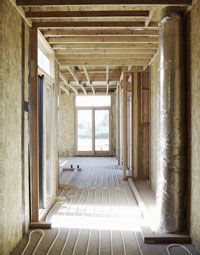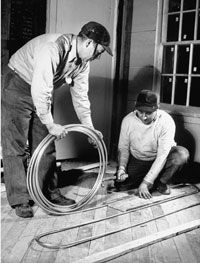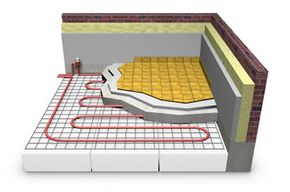The popularity of radiant heating systems is surging, and you don't have to be a homebuilder to understand why. Picture this: it's a cold morning, and you awaken to snow falling outside your bedroom window. It's hard to peel yourself from the coziness of your down comforter — but your morning cup of joe isn't going to make itself.
You slip out of bed and put your bare feet on a warm hardwood floor. When you head to the bathroom, you encounter heated ceramic tiles. In the kitchen, your feet meet a warm, tiled floor. Sounds like you're enjoying the benefits of radiant heating. Or, in this case, radiant floor heating.
Advertisement
Though some radiant heat systems use radiant heating panels to distribute warmth throughout the home, the most common household radiant heating system option by far is radiant floor heating (RFH).
An RFH system involves installing electric heating coils or water-heated tubing beneath the floors of your home. With an RFH system, the heat from the floor warms everything it touches and radiates throughout the room from the ground up.
Think of RFH like heat from the sun. On a sunny day, if you step from the shade into the sun, you'll feel warmer even though the air temperature is basically the same. This is how radiant floor heating works. Temperature throughout the room is more constant than with your standard forced-air system, where the air rises, cools and then falls to the floor.
Aside from basking in consistent warmth from the floor to the ceiling, some people look for savings benefits with RFH systems. More economical to operate than furnaces, RFH can slash heating costs by 25 to 50 percent [source: U.S. Department of Energy]. New homes are the best candidates for a whole-house RFH system, but your existing home can also be successfully retrofitted. Some people with older homes choose single-room installations, like a kitchen or bathroom, instead of a whole-house system.
The concept for RFH isn't new. Ancient Romans used hot water pipes to warm floors, and it's been the preferred heating system in Europe since the 1970s. Aside from the long-term cost benefits, RFH heating is silent heat, with no loud air ducts or furnaces to deal with. It's also better than forced air systems for people with allergies — eliminating blown air can reduce dust mites significantly [source: Bottini Fuel].
RFH systems fall into two categories — electric floor heating and hydronic floor heating. In this article, we'll cover the pros and cons, costs, and methods of installing radiant floor heating.
Advertisement


